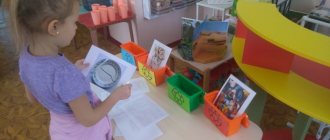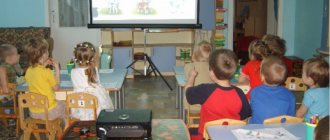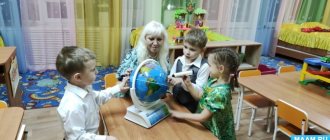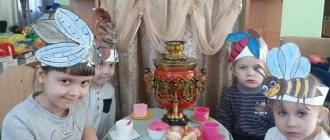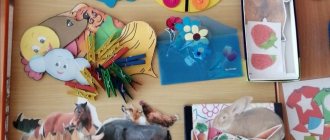Middle group. Junior preschool age. Children 4 - 5 years old
Environmental project "Ecolyats - preschool children" in the middle group Environmental project " Ecolyats - preschool children "
Middle group Justification of the problem.
The presence of global environmental environmental problems is a serious threat to all humanity in the modern world.
Today, the main task for people should be the preservation... Environmental social and educational project in the middle group (from 4 to 5 years old) “Eco-preschool children” Relevance of the Project One of the directions for the development of the state and the unification of a multinational society is the patriotic education of the younger generation. This is one of the priority areas in the Russian education system, contributing to the formation of...
Environmental project in the middle group “The world through the eyes of children”
author: Boldyreva Svetlana Aleksandrovna
Teacher, Samara MBDOU "Kindergarten 452 "Businka"
Environmental project in the middle group “The world through the eyes of children”
Environmental project in secondary group No. 4 “Chamomile” “The world through the eyes of children”
Educator: Boldyreva Svetlana Aleksandrovna MBDOU No. 452
PROJECT
on environmental education of middle group children
"The world of animals through the eyes of children"
Explanatory note.
The Year of Ecology has started across Russia. The problem of environmental education of preschool children is becoming particularly acute and relevant. It is during preschool childhood that the beginnings of ecological culture are formed. Therefore, it is very important to awaken in children an interest in living nature, to cultivate a love for it through knowledge of the world around them.
The role of animals in nature is so great that a person could hardly not only get along, but even simply live without them. And the point is not only that animals provide man with food, fur and wool, and serve him with their strength, speed and endurance. There is no doubt that the “Red Book”
Both nature reserves and national natural parks are very necessary for the protection of wildlife. But even more important is the responsibility for nature that every person bears.
Students from our group also actively participated in environmental events. We invited the families of our pupils to participate in the project “The World of Animals through the Eyes of Children”.
The project will take place in 4 stages:
- “Animals through the eyes of children” (drawings of animals of the Krasnodar region)
; - Exhibition on the theme “Animal diversity” (crafts and needlework)
; - “Sea inhabitants” (drawings of the inhabitants of the Black Sea)
; - Tabletop mini-presentations “My Pet” (photo collages, folding albums about pets)
.
Children can display their desire to protect nature in their creative works.
The best works will take part in the design of a kindergarten gift calendar.
Project goal: to create conditions for the development of children’s cognitive and creative abilities in the process of developing a child-adult educational project “The Animal World through the Eyes of Children”
in pupils of middle preschool age.
In accordance with the goal, the following project objectives were formulated:
- Enriching and deepening children's understanding of the animals of their native land, their diversity and living conditions.
- To develop knowledge about the interconnection of all living things in nature, to promote awareness of the special relationship of people to animals and to nature in general.
- Analyze educational and methodological literature on environmental education of middle-aged children;
- Enrich and consolidate the knowledge and ideas of preschoolers about animals living in our forests.
- Teach children to have a kind attitude towards animals.
- Supplement didactic material on environmental education of middle-aged children;
- Develop a system of games that ensure the consistent development of children in the context of play activities;
- Develop information sheets for parents with recommendations for familiarization with this topic.
- Enrich children's vocabulary with names of signs and actions by designating qualities (features of appearance, nutrition, habits)
. - Introduce children to the concept of “Red Book”
. - To develop children's coherent speech through writing a descriptive story about animals and retelling a literary text.
The novelty of the project will be the use of information and communication technologies that help improve the quality, accessibility and effectiveness of environmental education for children. This will make it possible to form elements of logical thinking and develop the intellectual abilities of children, without violating the laws and stages of mental and physiological development, and also taking into account the individual characteristics of children, which makes teaching children interesting, meaningful, and unobtrusive.
Implementation period: long-term, January 2022. – August 2022
Type of project: educational - gaming.
Project participants: middle school students, parents, teacher.
By number of participants: collective.
Form of organization of children: group, subgroup and individual.
Basic principles of project implementation:
— Accessibility (correspondence of the didactic task to the age and individual capabilities of children);
— Repeatability (consolidating and complicating the same game)
;
— The relevance of didactic material (up-to-date formulations of environmental problems, visual aids, etc.) actually helps children perceive tasks as a game, feel interested in getting the right result, and strive for the best possible solution;
— Collectivity (allows you to unite the children's team into a single group, into a single organism capable of solving problems of a higher level than those available to one child, and often more complex);
— Competitiveness (creates in a child or a subgroup the desire to complete a task faster and better than competitors, which allows reducing the time to complete the task on the one hand, and achieving a truly acceptable result on the other);
— An element of novelty (the introduction of new attributes, schemes, samples, the possibility of creativity, changing the rules).
Working hypothesis - it is assumed that organized work on environmental education of preschool children in accordance with modern requirements will help to increase the level of development of children's cognitive abilities.
Project implementation stages:
- Preparatory.
At this stage the following activities were carried out:
Studying the level of knowledge on the topic;
Monitoring diagnostics of children;
Drawing up a work plan for project implementation;
Creation of a subject-developing environment on the topic of the project;
Selection of teaching materials, illustrations, photographs, poems, presentations, didactic games, audio and video recordings on this topic;
Preparation of consultations, messages and teaching aids for parents;
Interaction with parents:
- Joint production of didactic games “Where is whose house?”
,
“Whose baby?”
and etc. ; - Assistance in the creation and design of an exhibition on the topic: “Diversity of animals” (crafts and needlework)
; - Tabletop mini-presentations “My Pet” (photo collages, folding albums about pets)
.
Analysis and generalization of existing work experience on this topic in preschool educational institutions;
Studying the experience of other educational institutions.
- Basic.
At this stage, practical work is carried out in order to obtain a high-quality result of this project. Namely:
Conversations with children, solving riddles;
Examination of illustrations, postcards, books on the topic;
View presentations on the topic;
Familiarity with objects in the immediate environment;
Reading fiction and memorizing rhymes;
Children reading poems;
Conducting didactic, plot-role-playing, movement, tabletop and finger games;
Theatrical activities;
Exhibitions of children's drawings “Animals through the eyes of children”
and
"Sea Life"
;
Dramatization “How the animals became friends”
;
Consultations for parents on the topic: “Environmental education of middle-aged children”
.
Creative and productive activities: modeling, drawing, appliqué (joint work of children with parents, independent activity of children;
Watching animated films about animals.
Listening to music.
Business game with parents: “How to understand the world of ecology?”
. Conducting consultations, developing recommendations and manuals for parents.
- Final.
- Positive dynamics of monitoring on environmental education of children of middle preschool age;
- Exhibition of joint creativity between children and parents;
- Creation of a gift calendar “The world of animals through the eyes of children”
, together with parents.
Expected result:
The project will contribute to the development of children’s cognitive and creative abilities, clarify and consolidate ideas about wild animals, habitats and food. The various situations and games used in this project will generate interest, curiosity, and attention in students.
Parents will receive methodological recommendations on creating conditions for conducting didactic games, advice on purchasing and making didactic games, since with the help of games and manuals, preschool children will unnoticed enter the world of ecology. Exciting games will help make the educational process not difficult or boring, but interesting and entertaining!
By implementing this project, we will try to help each child expand their horizons in their immediate environment, as well as create conditions for the development of independent cognitive activity. This project will provide each child with the opportunity not only to gain knowledge, but also to develop creative abilities, develop communication skills, and form the initial prerequisites for research activities. In turn, parents will develop an interest in the educational process, the development of creativity, knowledge and skills in children, a desire to communicate with teachers, and participate in the life of the group.
Bibliography:
- FROM BIRTH TO SCHOOL. Approximate basic general education program for preschool education / Ed. N. E. Veraksy, T. S. Komarova, M. A. Vasilyeva. – 3rd ed., rev. And additional – M.: MOSAIKA – SYNTHESIS, 2012;
- Federal State Educational Standards for Preliminary Education: implementation practice. – M.: Publishing house “Teacher”
, 2014. - Bashaeva T.V. Development of perception in children. Shape, color, sound. — Yaroslavl: Development Academy, 2007;
- Dybina O. V. The child and the world around him. Program and methodological recommendations. – M.: MOSAIKA – SYNTHESIS, 2010;
- Evdokimova E. S. Pedagogical support for families in raising a preschooler. – M.: TC Sfera, 2008.
- Lykova I. A. Visual activities in kindergarten. Middle group. – M.: “Color World”
, 2012. - Mikhalevskaya I. A., Masterkova E. A. A large reader for preschoolers. – M.: My World, 2008.
- Oberemok S. M. Project method in preschool education: Educational manual. – Novosibirsk: NIPKiPRO, 2007.
- Solomennikova O. A. Environmental education in kindergarten. Program and methodological recommendations. – 3rd ed., rev. and additional – M.: MOSAIKA – SYNTHESIS, 2009;
- Pilyugina V. A. Baby’s sensory abilities: Games to develop the perception of color, shape, size in young children. – M.: enlightenment. JSC "Ucheb.
met" 1996; - Collection of Russian folk tales. Ed. R. Kobzareva. – M.: Publishing house “Altey”
, 2012. - Soboleva A.V., Riddles - savvy. Practical guide for speech therapists, educators and parents - M.: “Publishing house GNOM and D”, 2000
Environmental project in the middle group “The world through the eyes of children”
Interaction with parents
Children's consciously correct attitude towards nature is based on its sensory perception, emotional attitude towards it and knowledge of the characteristics of life, growth and development of individual living beings, some biocenoses, knowledge of the adaptive dependencies of the existence of living organisms on environmental factors, relationships within natural communities. Such knowledge in the process of a child’s communication with nature provides him with an understanding of specific situations in the behavior of animals, the state of plants, their correct assessment and adequate response.
One of the conditions for successfully instilling the fundamentals of environmental culture is not only working with children, but also with their families. Environmental education of preschool children can be considered as a process of continuous education of parents, aimed at developing an environmental culture of all family members. Environmental education (enlightenment) of parents is one of the extremely important and at the same time one of the most difficult areas of work of a preschool institution.
